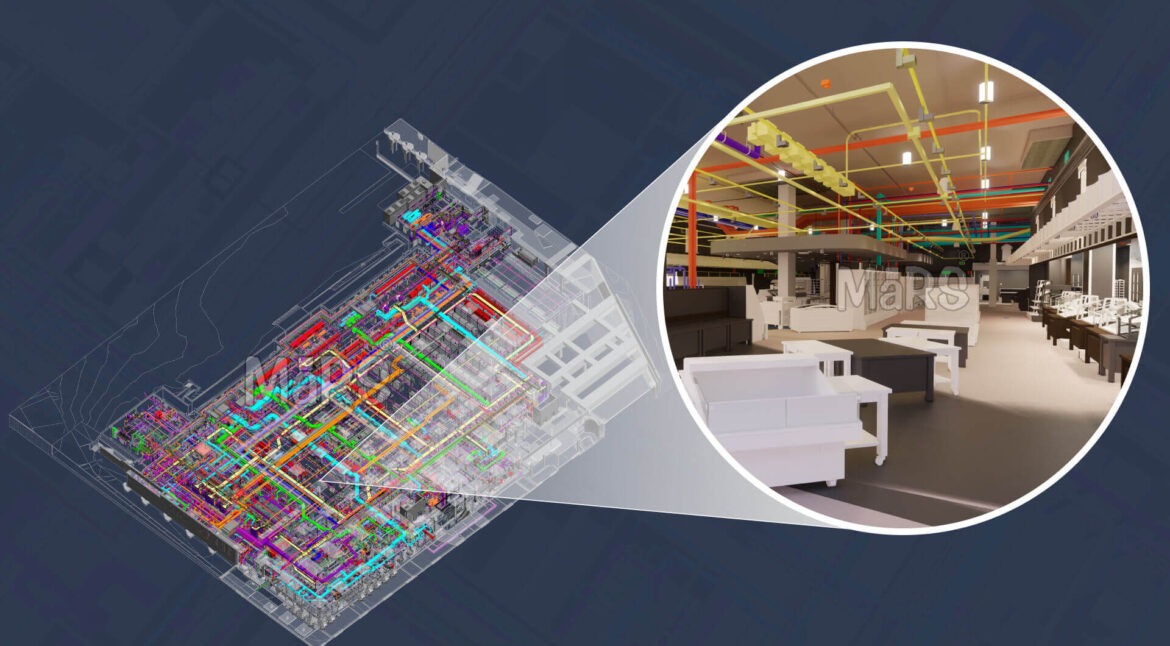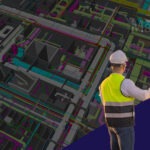Technology integration has become essential in the rapidly changing construction industry. Building Information Modeling (BIM) is one of the most revolutionary tools available today, enabling the smooth integration of diverse building systems. Integrating Mechanical, Electrical, and Plumbing (MEP) systems within the BIM framework is the primary goal of the MEP BIM coordination services, which are an essential part of this technology. These services are essential to ensuring that MEP systems are not only effectively designed but also smoothly integrated with the project’s structural and architectural components.
Construction teams may reduce costly errors that often occur during the process, prevent conflicts between various building systems, and enhance communication by using BIM MEP services. These services improve design accuracy, facilitate real-time collaboration, and ensure that projects follow sustainability and safety regulations. MEP BIM coordination becomes even more important as construction projects become more complex to deliver high-quality, cost-effective, and effective outcomes. These services, which range from prefabrication to facility management, are essential to effectively completing any modern construction project.
Role of MEP BIM Coordination Service in Modern Construction
Enhancing Collaboration with BIM MEP Services
The foundation for effective communication and coordination between the various teams working on construction projects is MEP BIM services. Contractors, architects, and MEP engineers can all visualize and coordinate their work in one unified environment by using the BIM model. This eliminates the traditional approach, in which every discipline operates independently and frequently causes delays and conflicts. Instead, the BIM model makes it possible for data and design updates to be shared in real-time, guaranteeing that all parties are in sync during the project.
The Vital Role of MEP BIM Coordination Services
The coordination of the different MEP systems within a building is largely dependent on MEP BIM coordination services. With the help of these services, plumbing, electrical, and mechanical systems are successfully integrated into the structural and architectural design. This process is managed by the MEP BIM coordinator, who also resolves conflicts between systems early in the design stage to avoid expensive and time-consuming changes later. Teams can visualize the exact location of every component by using detailed MEP BIM coordination drawings, which helps to prevent conflicts on-site and facilitates a smoother project delivery process.
Streamlining Construction with BIM MEP Coordination
BIM MEP coordination helps construction projects operate more efficiently. Before construction begins, the coordination process helps in locating and resolving any design or system conflicts. By taking a proactive stance, mistakes and rework are less likely to occur, which helps projects stay on track and under budget. This level of accuracy is essential in modern construction to maintain project growth, especially when working with complex structures and restricted schedules.
The Expertise of BIM MEP Engineers
Any project involving MEP systems needs a BIM MEP engineer to be successful. These experts design and coordinate the plumbing, electrical, and mechanical systems with the building’s architecture using modern BIM tools. Their knowledge guarantees that every system is not only effectively designed but also functions smoothly with every other system. BIM MEP engineers are experts in the use of software such as Revit, that allows the production of complex 3D models that include each component of a building’s infrastructure.
Creating Comprehensive MEP BIM Coordination Drawings
In modern construction processes, accurate and complete MEP BIM coordination drawings are essential. By functioning as a visual guide, these drawings make sure every MEP component is placed correctly and works in combination with other building systems. These necessary designs are provided by MEP BIM drawing services, reducing the possibility of mistakes during construction. Teams can identify potential conflicts early and make necessary adjustments before any physical work is done by visualizing the entire MEP layout in a 3D model.
Optimizing Project Costs
Reducing overall project costs is one of the most important advantages of MEP BIM services. These services prevent expensive mistakes that might occur during construction by expecting conflicts and optimizing system layouts. Stakeholders can make well-informed decisions about labor requirements, system efficiency, and material usage using the detailed models produced by BIM MEP engineers. Project budgets are maintained as a result of accurate resource allocation and cost estimation.
Improved Safety and Compliance through BIM MEP Coordination
Modern construction depends heavily on safety and regulatory compliance, especially given the growing complexity of construction regulations and standards. All mechanical, electrical, and plumbing systems have been designed according to building regulations as well as safety standards by using MEP BIM coordination services. Contractors can see the safest and most effective ways to install these systems using MEP BIM coordination drawings, which reduces the possibility of on-site errors or breakdowns to comply with local regulations.
Facilitating Prefabrication
MEP BIM drawing services are now even more valuable because of the increasing popularity of prefabrication in the construction industry. Since prefabricated parts are frequently produced off-site, careful on-site installation is required. The detailed 3D models provided by MEP BIM coordination ensure that prefabricated parts fit seamlessly into the overall building design. This reduces installation times, reduces mistakes, and improves project efficiency all around, especially for big projects with restricted deadlines.
Related Blog: MEP Coordination: Explanation and Process
Improved Facility Management with BIM MEP Coordination
The building’s operational stage benefits from MEP BIM coordination services even after construction is finished. Facility managers can monitor and maintain the mechanical, electrical, and plumbing systems of a building with the help of accurate models and data generated by BIM and MEP tools. Facility management becomes more effective, and the potential of system interruptions is decreased because the 3D models offer a clear visual reference for upcoming improvements, fixes, or system optimizations.
Supporting Sustainable Building Design
Energy-efficient building designs are becoming the top priority in modern construction, and BIM MEP services are essential to this effort. MEP engineers can simulate the performance of mechanical, electrical, and plumbing systems under real-world conditions using comprehensive BIM models. This makes it possible to integrate sustainable technologies such as water-saving plumbing designs, energy-efficient HVAC systems, and solar panels while optimizing energy consumption. Buildings that meet sustainability objectives and lower long-term operating costs are designed with the help of MEP BIM engineers.
Enhanced Communication with Stakeholders
It is often difficult to communicate with stakeholders on construction projects, especially when dealing with complex MEP systems. By providing all stakeholders with a shared visual platform, MEP BIM coordination facilitates this process. Clients, contractors, engineers, and architects can all easily review the MEP BIM coordination drawings and provide immediate feedback. This collaborative approach prevents misunderstandings and speeds up the decision-making process by guaranteeing agreement.
Enabling Better Asset Management with Detailed MEP BIM Models
In addition to construction, MEP BIM coordination helps with long-term asset management. Because a lot of data is integrated into MEP BIM models, building owners, and facility managers can keep an eye on the lifecycle of MEP components. Whether for regular maintenance, upgrades, or replacements, having access to these detailed models ensures better decision-making and more efficient management of building assets over time.
Real-Time Problem Solving with MEP BIM Coordination Services
Modern construction projects are often dynamic, developing throughout their lifecycle. You can quickly adapt to these changes with the flexibility offered by MEP BIM coordination services. In response to unanticipated issues on-site or changes in the design, the BIM MEP coordinator may quickly make adjustments to the model. Ensuring that changes are properly coordinated across all systems, reduces delays and maintains the project’s timeline.
Conclusion
The coordination of BIM and MEP is critical to the success of construction projects today. By combining various MEP systems into a single, unified model, MEP BIM coordination services enhance planning, reduce risks, and increase efficiency, making them a valuable asset in today’s construction industry. The future of the construction industry will depend on these services as technology develops and project complexity rises.
FAQs
What are BIM coordination services?
BIM coordination services involve integrating and managing various building systems (such as MEP) within a Building Information Modeling (BIM) framework to ensure accurate and efficient design, construction, and operation.
What are the roles and responsibilities of an MEP BIM coordinator?
An MEP BIM coordinator is responsible for overseeing the integration of Mechanical, Electrical, and Plumbing systems within the BIM model. They resolve design conflicts, ensure systems align with architectural and structural plans, and facilitate collaboration among various project teams.
What does MEP services encompass?
MEP services encompass the design, installation, and management of MEP systems in a building. This includes HVAC systems, lighting, power distribution, water supply, and drainage.
What is the cost of BIM coordination services?
The cost of BIM coordination services varies based on project size, complexity, and location. It generally includes fees for the BIM coordinator’s time, software, and any additional resources needed for effective coordination.
What are the advantages of BIM coordination?
The advantages of BIM coordination include reduced design conflicts, improved collaboration, cost savings through early clash detection, enhanced accuracy, and better overall project efficiency and management.
How does BIM coordination improve project outcomes?
BIM coordination improves project outcomes by enhancing accuracy in system design, reducing the risk of on-site conflicts, saving time and costs associated with rework, and facilitating better overall project management. It also supports effective facility management by providing detailed models for future maintenance and upgrades.
How does MEP BIM coordination impact project timelines?
MEP BIM coordination helps streamline project timelines by identifying and resolving design conflicts early in the process. This proactive approach reduces delays caused by on-site issues, allowing projects to stay on schedule and avoid costly interruptions.
What tools are commonly used in MEP BIM coordination?
Common tools used in MEP BIM coordination include Autodesk Revit, Navisworks, and BIM 360. These tools facilitate the creation and management of detailed 3D models, clash detection, and real-time collaboration among project teams.
How does MEP BIM coordination enhance sustainability in construction?
MEP BIM coordination supports sustainability by enabling more accurate modeling of energy systems, optimizing HVAC and lighting designs, and facilitating the integration of green technologies. This results in more energy-efficient buildings and reduced environmental impact.
What role does the MEP BIM coordinator play in managing project changes?
The MEP BIM coordinator plays a crucial role in managing project changes by updating the BIM model to reflect design modifications, assessing the impact of changes on MEP systems, and ensuring that all stakeholders are informed and aligned with the revised plans.
How does MEP BIM coordination support prefabrication in construction?
MEP BIM coordination supports prefabrication by providing detailed and accurate models that guide the off-site manufacturing of MEP components. This ensures that prefabricated parts fit precisely into the building, reducing installation time and minimizing errors on-site.




